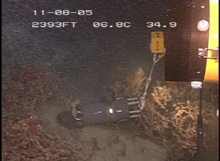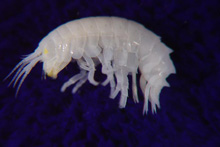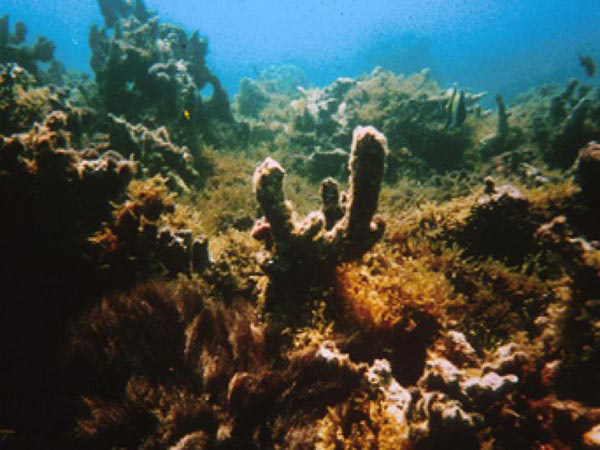Figure 1: Two views of a glass sponge in the class Hexactinellida. Click image for larger view and image credit.

Figure 2: Two views of an Anthomastus sp. octocoral (the red coral). The thin corals on the upper left are bamboo corals. Encrusting colonial organisms are growing on dead coral in the center and right of the image. Click image for larger view and image credit.
Canaveral Deep Dive
November 8 , 2005
Sandra Brooke, Ph.D.
Principal Investigator
Research Associate
Oregon Institute of Marine Biology
![]() View
video footage captured at 2,400 feet on the south side of one of
the many pinnacles off Cape Canaveral. (Quicktime, 1.3 Mb.)
View
video footage captured at 2,400 feet on the south side of one of
the many pinnacles off Cape Canaveral. (Quicktime, 1.3 Mb.)
My first concern for this cruise was the weather – trying to do submersible operations in November in the Florida Strait may not be the smartest thing to do!
However, Mother Nature was kind to us and the dive went ahead as planned. We dropped down to about 2,400 feet on the south side of one of the many pinnacles off Cape Canaveral. The bottom resembled a shallow tropical lagoon, illuminated by the lights from the sub and complete with sand ripples. We ran a transect upslope and soon came across thickets of intact but mostly dead Lophelia coral, which is a common phenomenon on these deepwater reefs.
We don’t really know why this is the case; coral could be killed by sediment storms that suffocate the polyps, temperature anomalies or even disease. Even though the coral is mostly dead, it still provides good habitat for lots of other creatures. The steep slope was covered in a wide array of delicate glass sponges (Figure 1), bamboo corals, and small bright red soft corals (Figure 2).
Most types of soft corals and sponges need a stable substrate to settle and grow, and the Lophelia skeleton provides this in abundance. In the small spaces between the coral branches, small galatheid crabs could be seen and there is a common polychaete worm (Eunice sp.) that makes its home in the Lophelia skeleton.
 Figure 3: A new prototype of Dr. Grant Gilmore’s acoustic listening device deployed on the bottom. This was the first test for this device; additional tests are planned during this expedition. Sounds were recorded during the initial deployment, but the amplitude was too low for adequate scientific analysis. Click image for larger view and image credit.
Figure 3: A new prototype of Dr. Grant Gilmore’s acoustic listening device deployed on the bottom. This was the first test for this device; additional tests are planned during this expedition. Sounds were recorded during the initial deployment, but the amplitude was too low for adequate scientific analysis. Click image for larger view and image credit.

Figure 4: Dr. Jim Thomas believes this to be a new species of a commensal amphipod. This 7-8 mm. long specimen was discovered inside a Hexactinallid sponge. Click image for larger view and image credit.
After reaching the top of the pinnacle at approximately 2,300 feet depth, we found a good place to deploy Dr. Grant Gilmore’s acoustic fish listening device (Figure 3). We had seen a few fish during our travels, including conger eels, but many fish are scared away by the lights and noise of the submersible. The acoustic device allows us to eavesdrop on the fish while they are behaving naturally. Dr. Gilmore can then determine which fish were around, and also what they were doing. We attached a ‘pinger’ to the device, which produces a sound (ping!) at pre-set intervals.
On a subsequent dive, the submersible can detect the sound and home in on the pinger. This allows us to find equipment again after we have deployed it, and is extremely useful when working in a large complex habitat.
We then ran a transect along the top of the pinnacle, which was small but had several ridge features. There was more live coral up on top of the pinnacle so we collected some small pieces for our genetics and reproduction projects.
We also collected some glass sponges for Dr. Jim Thomas, who is looking for small crustaceans called amphipods that hide in the sponges. He found a new family of amphipod from the collections on our first dive! (Figure 4) We then ran another transect up the north slope, which was even steeper than the south and had similar abundant and diverse associated fauna. We wrapped up the dive 3 hours after leaving the surface and arrived on deck just in time for lunch!
Florida Coast Deep Corals will be sending daily reports from Nov 7 - 21. Please check back frequently for additional logs from this expedition.
Sign up for the Ocean Explorer E-mail Update List.

























